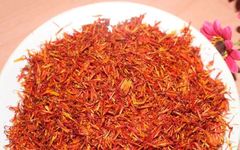Safflower (Honghua) is a commonly used herb in daily life, known for its ability to invigorate blood circulation, regulate menstruation, and alleviate pain. Clinically, it is often used for conditions such as blood stasis leading to amenorrhea, dysmenorrhea, traumatic injuries, and rheumatic pain. Below, let us explore in detail the efficacy and functions of safflower.
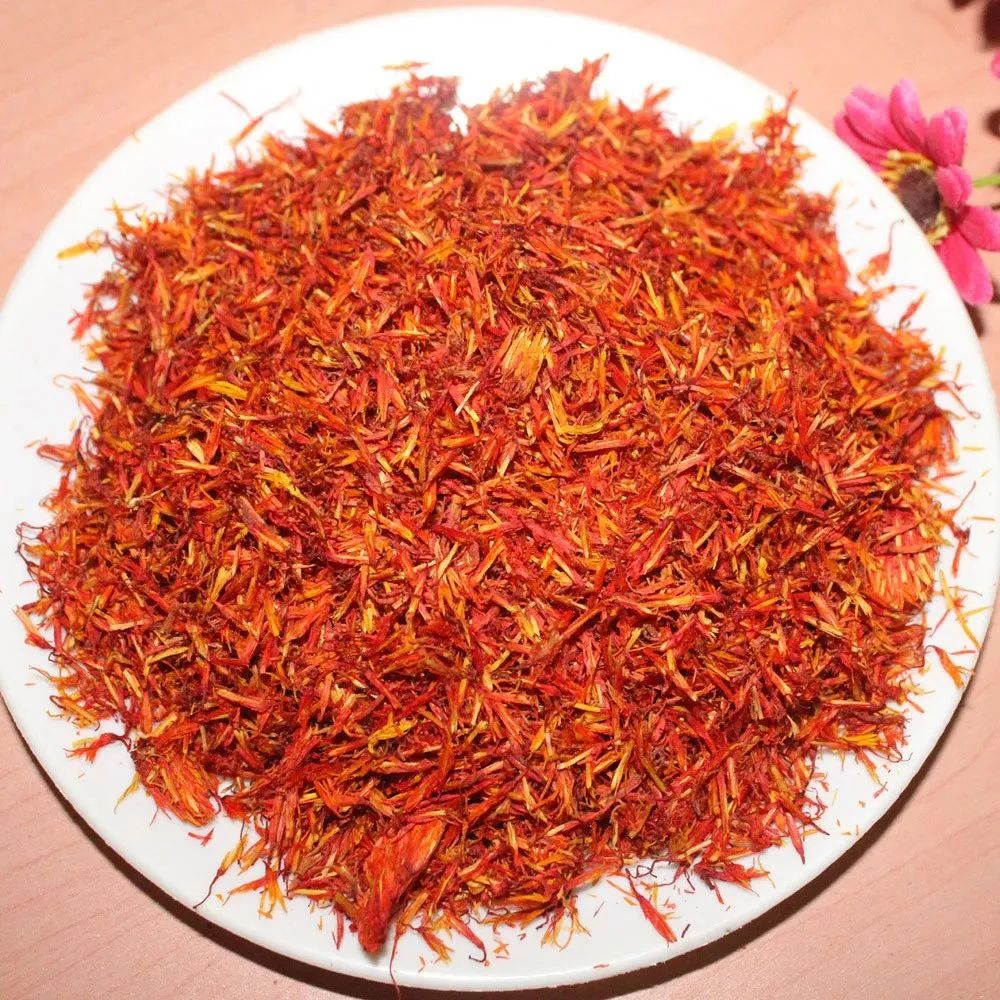
Safflower is also known as Honglanhua (红蓝花) in the “Jinkui Yaolue”, and as Cihonghua (刺红花) in the “Sizhou Zhongyao Zhi”. The medicinal part is the flower of the Asteraceae plant, harvested when the petals change from yellow to red, typically in May to June, and then dried.
The plant is an annual herb, growing 30 to 90 cm tall, with a smooth and hairless texture. The stem is erect, woody at the base, and branched at the top. The leaves are alternate, hard in texture, nearly stemless, and embrace the stem; they are ovate or ovate-lanceolate, measuring 3.5 to 9 cm in length and 1 to 3.5 cm in width, with a gradually narrowing base and a sharp tip, serrated edges; the upper leaves gradually reduce in size, forming bracts around the head-like inflorescence. The inflorescence is large and terminal, with many involucral bracts, the outer 2 to 3 rows leaf-like and lanceolate with spiny edges; the inner bracts are ovate, membranous and white-edged; the flower receptacle is flat; there are many tubular flowers, usually bisexual, orange-red, with 5 lobes at the tip, and the lobes are linear; there are 5 stamens with fused anthers; 1 pistil with a long style extending beyond the anther tube, and a 2-lobed stigma with short lobes. The achene is oval or inversely ovate, about 5 mm long, slightly oblique at the base, white, and has 4 ribs. The flowering period is from June to July, and the fruiting period is from August to September.
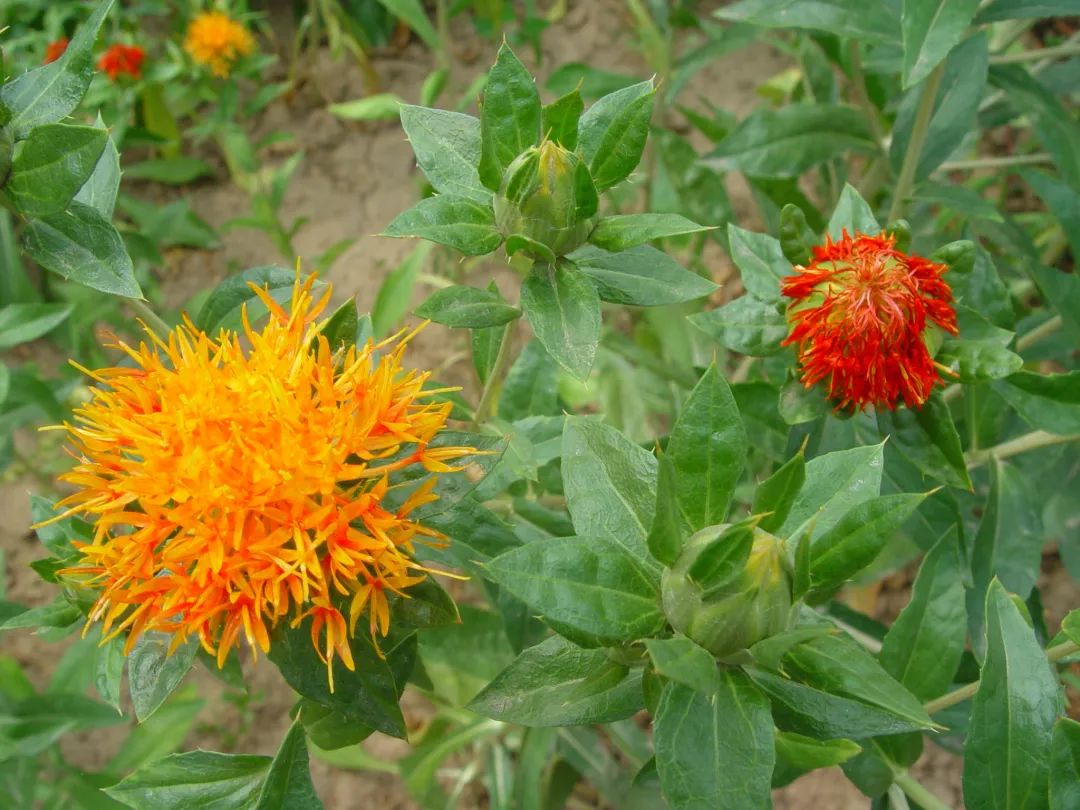
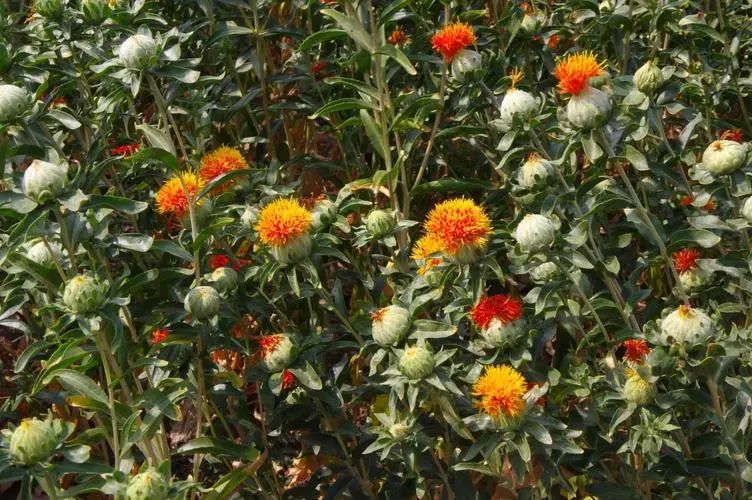
Preparation: Remove impurities, discard stems and leaves, and dry.
Meridian Affinity: Heart (Xin) and Liver (Gan).
Properties: Pungent in flavor; warm in nature.
Precautions: Not suitable for pregnant women.
Functions and Indications: Invigorates blood circulation and regulates menstruation; alleviates pain and removes blood stasis. It is indicated for amenorrhea, dysmenorrhea, postpartum abdominal pain due to blood stasis, chest pain due to blood stasis, traumatic injuries, joint pain, stroke sequelae, and rashes.
Dosage: For internal use: decoction, 3-10g. Use less for nourishing blood and harmonizing blood; use more for invigorating blood and removing stasis.
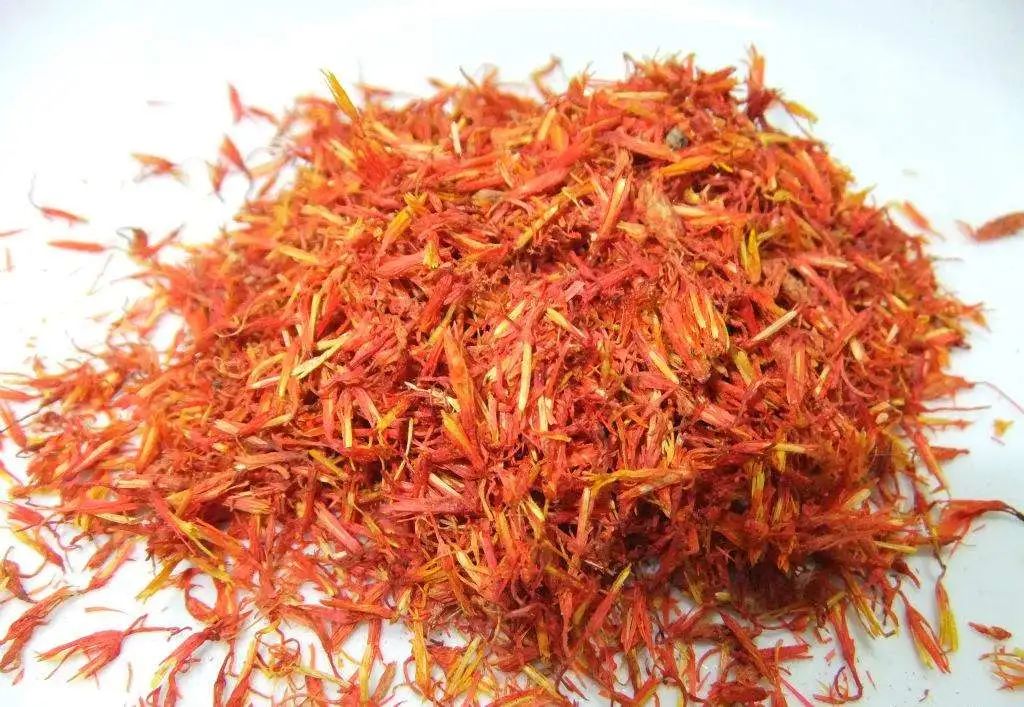
The efficacy and functions of safflower:
1. Dissolving Stasis and Reducing Spots: Safflower can invigorate blood circulation and open the meridians to dissolve stasis and reduce spots, making it useful for treating rashes with dark colors caused by blood heat stagnation. It can also effectively prevent and improve skin issues such as measles and rashes, making it a great choice for women’s beauty and skin care.
2. Lowering Blood Lipids: The safflower oil component has the effect of lowering blood lipids, which can reduce total cholesterol, triglycerides, and non-esterified fatty acids levels.
3. Invigorating Blood and Regulating Menstruation: Safflower is pungent and warm, entering the blood level, which can invigorate blood, remove stasis, and alleviate dysmenorrhea. It is a good health supplement for women and the elderly, but should not be used in excess. In fact, the stasis-dissolving effect of safflower is stronger than its blood-invigorating effect, making it a common herb for regulating menstruation, often used to treat dysmenorrhea, menstrual irregularities, amenorrhea with abdominal pain, and postpartum complications such as prolonged lochia and abdominal pain.
4. Reducing Swelling and Alleviating Pain: Safflower has the effect of reducing swelling and alleviating pain, suitable for various blood stasis conditions such as chest pain, rib and abdominal pain, subcutaneous bruising, and stroke sequelae. Additionally, it is very effective for pain in the limbs caused by traumatic injuries or contusions.
5. Lowering Blood Pressure: The yellow pigment in safflower can dilate peripheral blood vessels, inhibit platelet aggregation, enhance fibrinolysis, and reduce whole blood viscosity, thereby lowering blood pressure.
Contraindications for Safflower:
Pregnant women should avoid it: Safflower is believed to stimulate the uterus, and pregnant women should avoid consuming it to prevent miscarriage.
Excessive consumption: Safflower is a spicy condiment, and excessive consumption may lead to gastrointestinal discomfort, dizziness, dry mouth, and other adverse symptoms.
Allergic reactions: Some individuals may experience allergic reactions to safflower, such as rashes or difficulty breathing. If allergic symptoms occur, consumption should be stopped immediately.
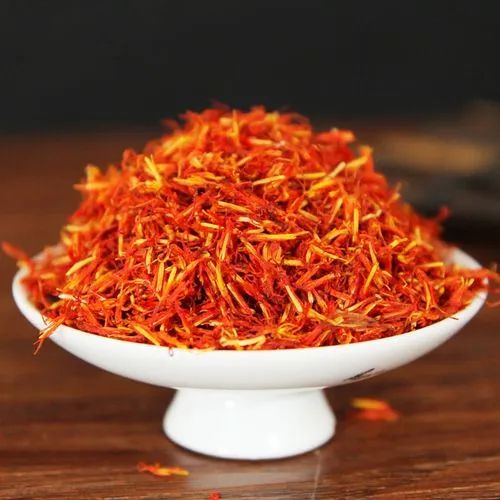
Selected Formulas:
1. For women with obstructed menstruation due to blood stasis: Safflower (finely chopped), Su Fang Mu (crushed), and Dang Gui (Angelica) in equal parts. Finely chop, use one tael, with 1.5 liters of water, first decoct the flowers and wood, then add one cup of wine and Dang Gui, decoct again, and take warm before meals. (From “Zhu’s Collection of Verified Medical Formulas”)
2. For women suffering from various types of wind and abdominal blood stasis pain: One tael of safflower. Decoction with one large liter of wine, reduce to half, take half at once, and if pain persists, take again. (From “Jinkui Yaolue” Safflower Wine)
3. For all types of swellings: Safflower, mashed and juiced for oral consumption. (From “Secret Formulas of External Medicine”)
4. For throat obstruction and blockage: Safflower juice, one small liter, taken as needed. If there is no moisture in winter, use dried flowers soaked to extract juice, and take as before. (From “Haishang Collection of Verified Formulas”)
5. For traumatic injuries and wall crush injuries: 1 part Chuan Ma, 2 parts Mu Xiang, 3 parts Safflower, and 4 parts Licorice. All used raw, ground into powder, and taken with yellow wine. (From “Emergency Formulas”)
6. For bedsores: Appropriate amount of safflower, soaked in wine for external application. (From “Yunnan Herbal Medicine”)
Note: This account aims to promote Traditional Chinese Medicine culture, and the TCM knowledge mentioned in the text is for learning and exchange purposes only.
WeChat has been updated! If you neither starred me nor liked or viewed my articles, the system will assume you do not wish to receive information about herbal medicine, and ultimately, you will not receive our article updates.
Thank you for your patience in reading. If you find it interesting, please click “like” at the bottom.
As the saying goes, “In a group of three, there must be a teacher for me.” To facilitate the integration and exchange of knowledge among TCM practitioners, we are preparing to establish a discussion group. If you wish to join, please add the editor on WeChat and specify your identity. The editor invites you to join the group.


